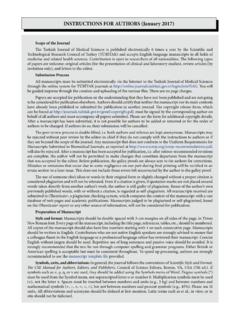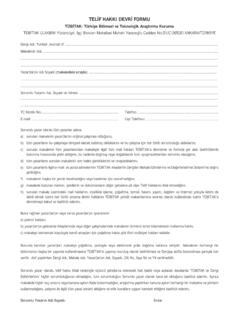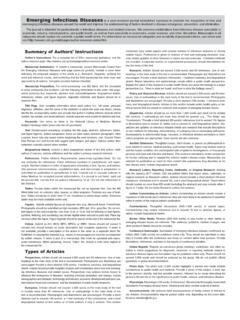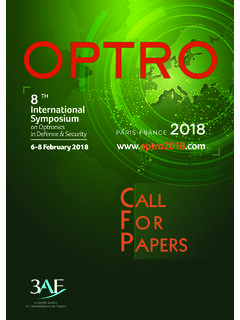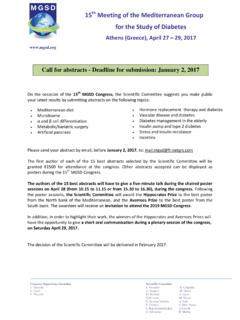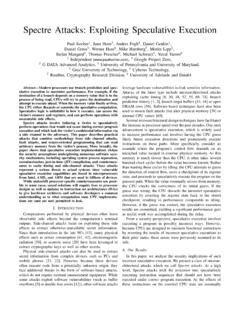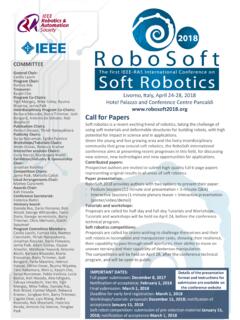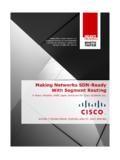Transcription of INSTRUCTIONS FOR AUTHORS (January 2017) - …
1 INSTRUCTIONS FOR AUTHORS ( january 2017 )Scope of the JournalThe Turkish journal of veterinary and Animal Sciences is published electronically 6 times a year by the Scientific and Technological Research Council of Turkey (T B TAK) and accepts English-language manuscripts on all aspects of veterinary medicine and animal sciences. Contribution is open to researchers of all nationalities. Original research articles, review articles, short communications, case reports, and letters to the editor are welcome. Manuscripts related to economically important large and small farm animals, poultry, equine species, aquatic species, and bees, as well as companion animals such as dogs, cats, and cage birds, are particularly welcome. Contributions related to laboratory animals are only accepted for publication with the understanding that the subject is crucial for veterinary medicine and animal science.
2 Manuscripts written on the subjects of basic sciences and clinical sciences related to veterinary medicine, nutrition, and nutritional diseases, as well as the breeding and husbandry of the above-mentioned animals and the hygiene and technology of food of animal origin, have priority for publication in the journal . A manuscript suggesting that animals have been subjected to adverse, stressful, or harsh conditions or treatment will not be processed for publication unless it has been approved by an institutional animal care committee or the equivalent thereof. The editor and the peer reviewers reserve the right to reject papers on ethical grounds when, in their opinion, the severity of experimental procedures to which animals are subjected is not justified by the scientific value or originality of the information being sought by the author(s).
3 Submission ProcessAll manuscripts must be submitted electronically via the Internet to the Turkish journal of veterinary and Animal Sciences through the online system for T B TAK journals at You will be guided stepwise through the creation and uploading of the various files. There are no page are accepted for publication on the understanding that they have not been published and are not going to be considered for publication elsewhere. AUTHORS should certify that neither the manuscript nor its main contents have already been published or submitted for publication in another journal . The copyright release form, which can be found at , must be signed by the corresponding author on behalf of all AUTHORS and must accompany all papers submitted. Please see the form for additional copyright details.
4 After a manuscript has been submitted, it is not possible for AUTHORS to be added or removed or for the order of AUTHORS to be changed. If AUTHORS do so, their submission will be peer review process is double-blind, both AUTHORS and referees are kept anonymous. Manuscripts may be rejected without peer review by the editor-in-chief if they do not comply with the INSTRUCTIONS to AUTHORS or if they are beyond the scope of the journal . After a manuscript has been accepted for publication, after referee-recommended revisions are complete, the author will not be permitted to make changes that constitute departures from the manuscript that was accepted by the editor. Before publication, the galley proofs are always sent to the AUTHORS for corrections. Mistakes or omissions that occur due to some negligence on our part during final printing will be rectified in an errata section in a later issue.
5 This does not include those errors left uncorrected by the author in the galley use of someone else s ideas or words in their original form or slightly changed without a proper citation is considered plagiarism and will not be tolerated. Even if a citation is given, if quotation marks are not placed around words taken directly from another author s work, the author is still guilty of plagiarism. Reuse of the author s own previously published words, with or without a citation, is regarded as self-plagiarism. All manuscripts received are submitted to iThenticate , a plagiarism checking system, which compares the content of the manuscript with a vast database of web pages and academic publications. Manuscripts judged to be plagiarised or self-plagiarised, based on the iThenticate report or any other source of information, will not be considered for of ManuscriptStyle and format: Manuscripts should be double-spaced with 3-cm margins on all sides of the page, in Times New Roman font.
6 Every page of the manuscript, including the title page, references, tables, etc., should be numbered. All copies of the manuscript should also have line numbers starting with 1 on each consecutive page. Contributors who are not native English speakers are strongly advised to ensure that a colleague fluent in the English language or a professional language editor has reviewed their manuscript. Concise English without jargon should be used. Repetitive use of long sentences and passive voice should be avoided. It is strongly recommended that the text be run through computer spelling and grammar programs. Either British or American spelling is acceptable but must be consistent throughout. To speed up processing, AUTHORS are strongly recommended to use the manuscript template file , units, and abbreviations: In general, the journal follows the conventions of Scientific Style and Format, The CSE Manual for AUTHORS , Editors, and Publishers, Council of Science Editors, Reston, VA, USA (7th ed.)
7 If symbols such as , , , or are used, they should be added using the Symbols menu of Word. Degree symbols ( ) must be used from the Symbol menu, not superscripted letter o or number 0. Multiplication symbols must be used ( ), not the letter x. Spaces must be inserted between numbers and units ( , 3 kg) and between numbers and mathematical symbols (+, , , =, <, >), but not between numbers and percent symbols ( , 45%). Please use SI units. All abbreviations and acronyms should be defined at first mention. Latin terms such as et al., in vitro, or in situ should not be content: Research articles should be divided into the following sections. Principal sections should be numbered consecutively (1. Introduction, 2. Materials and methods, etc.) and subsections should be numbered , , etc.
8 Do not number the References sections. Research articles should be no longer than 15 pages, should have a limit of 30 references, and should have a limit of 8 figures and tables combined. Please see below for information about other types of manuscripts. All submissions must include a title page, which is to be uploaded as a separate document. Do not repeat the information from the title page within the main manuscript page The title page should contain the full title in sentence case ( , Histopathological changes in uncomplicated sole ulcers in dairy cattle), the full names (last names fully capitalised) and affiliations (in English) of all AUTHORS (Department, Faculty, University, City, Country), and the contact e-mail address for the clearly identified corresponding author.
9 Please include any necessary acknowledgements or disclaimers on the title page, as well. Do not repeat them in the main document. Names of funding organisations should be written in full. If your manuscript is accepted for publication, this information will be moved to the main document after the peer review process is and abstract The first page of the main manuscript should begin with the title. Do not include author names or affiliations here. Directly below the title, the abstract should provide clear information about the research and the results obtained, and should not exceed 200 words. The abstract should not contain wordsPlease provide no more than 6 key words or phrases to enable retrieval and indexing. Acronyms should be should argue the case for your study, outlining only essential background, and should not include the findings or the conclusions.
10 It should not be a review of the subject area, but should finish with a clear statement of the question being addressed. Materials and methodsPlease provide concise but complete information about the materials and the analytical and statistical procedures used. This part should be as clear as possible to enable other scientists to repeat the research presented. Brand names and company locations should be supplied for all mentioned equipment, instruments, chemicals, etc. A subsection detailing statistical methods used to summarise the data and test hypotheses and the level of significance used for testing the hypothesis should also be provided. Where techniques that have already been described in an indexed journal are used, this section should be concise and provide the relevant references.
